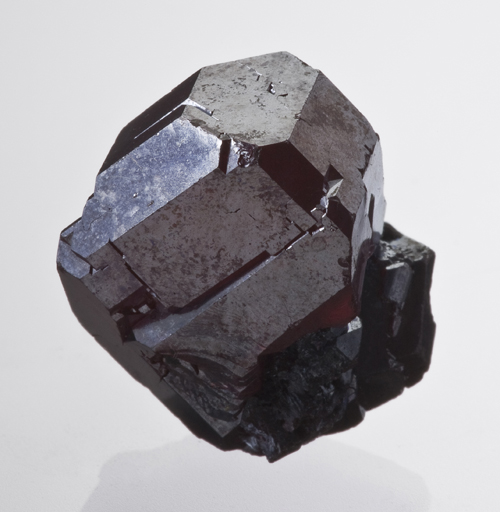The Mineral cuprite

Cuprite is named for the Latin cuprum, "copper", in allusion to its copper content. It can form as bright transparent red crystals, or as lustrous, submetallic opaque crystals. Even the opaque form will have slightly red edges and faint transparency upon back-lighting. Cuprite is often associated together with Native Copper in copper deposits, and frequently forms as an encrusting reddish coating over the Copper. Malachite is known to fully or partially coat a layer or pseudomorph over Cuprite, forming an interestingly shaped and a sometimes sparkling green crystal form.
Color
Bright-red, maroon, brownish-red, dark red, purplish-red, reddish-black, dark gray
Properties
Streak
Brownish-red |
Hardness
3.5 - 4 |
Transparency
Translucent to opaque |
Specific Gravity
6.1 |
Luster
Adamantine or submetallic |
Cleavage
3, all directions |
Fracture
Uneven |
Tenacity
Brittle |
Varieties
-
Variety of Cuprite composed of dense, hair-like or needle-like fibers.
Uses
Cuprite is an important collectors mineral, and is a minor ore of copper.
Noteworthy Localities
Some of the most outstanding lustrous dark red octahedral Cuprite crystals and groupings come from Kolwezi, Katanga (Shaba), Congo (Zaïre). Exceptionally large crystals, often coated with a shiny green coating of Malachite, are well-known from Ogonja, Seeis, Namibia; and a classic locality for fine Cuprite is Tsumeb, Namibia.
A relatively new Cuprite find producing outstanding lustrous dark gray octahedral crystal groupings is the Rubtsovoskoe Mine, near Poteryaevka, Altai, Russia. Cuprite crystals from this locality has become very popular among collectors. Fine sharp and lustrous octahedral Cuprite come from Dzezkazgan, Kazakhstan. In China, well-formed crystals and the Chalcocitrite variety have come from the Fengjiashan Mine, Daye, Hubei Province; and the Chengmenshan Mine, Jiurui, Jiangxi Province.
Bright cherry-red Cuprite crystals have come from the Red Dome Mine, Chillagoe, Queensland, Australia. Cornwall, England, is a classic producer, and this includes several localities in the Camborne/Redruth/St Day District; as well as Wheal Phoenix and Caradon, Linkinhorne, Liskeard District. In France, two noteworthy occurrences are Chessy, Rhône (especially noted for the Malachite pseudomorphs; and the Le Moulinal Mine, Paulinet.
In the U.S., excellent Cuprite specimens have come from many of the important copper deposits of Arizona, with the most notable and classic being Bisbee, Cochise Co. Other noteworthy Arizona localities are Ray, Pinal Co., Arizona; and the New Cornelia Mine, Ajo, Pima Co.
Distingushing Similar Minerals
Spinel - Much greater in hardness, has white streak.
Sphalerite - Different crystal habits and mode of occurrence.
Rutile - Greater hardness and different crystal forms.